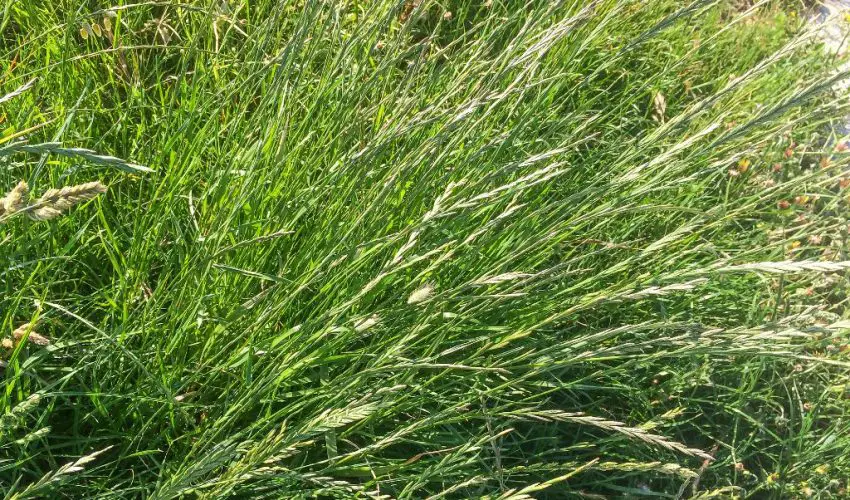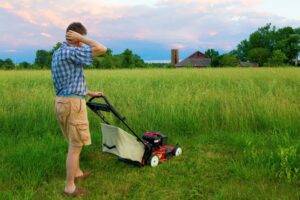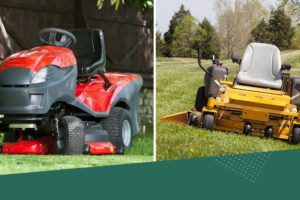Before that, however, let’s first know why annual ryegrass needs to be eliminated at certain times of the year and how to identify it and keep it from coming back.
Table of Contents
ToggleWhat is Ryegrass?
Annual ryegrass is a winter annual grass that grows anywhere in the U.S. It can grow a fibrous root system reaching up to 3 feet deep down into the soil. Farmers and ranchers find ryegrass useful as they use it as a cover crop for their cattle to graze on. Incidentally, ryegrass is also turfgrass that is used for overseeding lawns in cold winter months.
What Is the Problem with Ryegrass?
Despite its desirability due to being a highly adaptable and aggressive turfgrass, it also has similar characteristics to weed. It likes to grow in places where it is not wanted and eventually persists year in and year out. It then becomes an annual problem, which creates the need to remove it.
It was actually recognized as a good “nurse crop,” but then it has this rougher texture and grows faster at a lesser quality than most turfgrass owners would want to have. It also requires a lot of effort to maintain and keep it looking great. It may become more of a headache with the kind of upkeep that it requires.
Furthermore, when your green lawn turns brown as it becomes dormant in the fall, ryegrass would continue to look green throughout the cold season.
The thing is, if you don’t get rid of it by spring, it could continue to grow and expand and potentially overcome your warm-season grass.
What Does Ryegrass Look Like?
Like in many instances where you are looking to remove unwanted plants from your lawn, it is important to know exactly what you are looking for. Otherwise, you might end up wasting your time and resources by having to make repairs and restarting the whole process.
Below are some of the distinct characteristics of ryegrass:
- Annual ryegrass usually grows in bunches of dark green blades and visible ridges on the upper surface. Meanwhile, it is smooth and glossy on the lower surface.
- It has round ligules with an inflorescence that has many little spikelets on them. At the base of the tillers, you will find a red dot.
- Their leaf blades can grow anywhere between 2 to 8 inches in length and up to a quarter of an inch in width.
- You may also find a shade of red at its base.
- The seedhead is a long spike that can grow 5 to 16 inches long, containing spikelets coming up the stem.
How to find Ryegrass in Your Lawn
Ryegrass can grow in any part of your yard, especially where there is abundant moisture. But it is highly adaptable as it can practically grow everywhere. Check the severity of the problem and proceed with caution when using herbicides.
How to remove Ryegrass from the lawn
Here’s 3 different way on how you can remove ryegrass from your lawn:
Mowing Ryegrass
- First, find the locations of the ryegrass that you want to remove. Cut them down with a mower leaving only 1 inch of grass. Do this within three weeks before the last light freeze of spring, as it helps to kill this grass faster.
- Next, do not water your ryegrass in the next two weeks after mowing. No water means no growth and eventually dead grass
- Use white chalk powder to mark these locations, especially if you have a large lawn.
- Cover the mowed and marked areas with plastic or landscaping fabric to further deny the grass of essential elements like carbon dioxide and sunlight. These are just two of many used by plants to do photosynthesis.
- After that, you can always check back on these locations to remove newly grown ryegrass. Any time you see seedheads appear, mow them as soon as possible. It should kill them before they sprout anew. Inside of that two weeks, regularly check and remove the plastic to remove dead grass with a thatch rake.
- Aerate your yard with an aerator around 7 to 8 weeks before the warm season grass starts to come out of dormancy.
Digging up Ryegrass
This method involves physically digging up the grass for removal.
- Locate and identify the ryegrass that you want to remove.
- Mark the areas with chalk for removal and tracking for new growth.
- Using a garden spade, dig up at least 2 inches around the marked area and cut the roots within the soli. Although its roots go much longer, 2 inches of digging and cutting it is enough to stop it from growing.
- Cover the dug-up portions with landscaping fabric to deny the grass the essential elements to prevent it from growing and eventually kill it.
- Remove the fabric after 15 days and dig up the dead ryegrass. Use a thatch rake to further remove it by pulling it upwards to lift the thatch and aerate the spot.
- Remove any seed that you may find to prevent regrowth.
Remove Ryegrass Using Herbicides
- Head over to your nearest garden supply store and talk to qualified garden technicians who can recommend to you the best herbicide for your lawn and give you advice on how to use it.
- Strictly follow instructions on the label and wear protective clothing when applying it to the affected areas in your yard.
- Depending on where you live, you may spray herbicide on your yard between mid-April going into the first week of May. These times are when temperatures and soil conditions are ideal. Otherwise, you may ask your technician.
- Spray the affected areas as indicated in the instructions by using a garden sprayer.
- Reapply at least once a week to kill ryegrass right up until you your warm-season grass starts to turn green again.
- It is best to apply herbicides when your ryegrass isn’t fully grown, preferably under 7 inches. If it is already grown, it would be better to do the mowing or digging instead, since using herbicide, in this scenario, won’t be as effective as indicated
- Remember that herbicides will not work after seedhead emergence, and timing is everything. Consult your technician for the details about the best time and frequency for application. The best time to apply pre-emergent is around late summertime or the beginning of fall. Temperatures should be around 65 to 70 degrees F or lower.
- Do spot treatment as necessary.
- Avoid applying chemicals when it is raining as they would only be washed away or become diluted, rendering them ineffective.
- Do moving and digging solutions as an adjunct to the chemical method to prevent a recurrence.
Conclusion
Regular mowing and making sure that your favored grass is well-fertilized not only helps in the removal of unwanted ryegrass but also eliminates the possibility of it ever coming back. Enjoy your clean-up lawn day!





